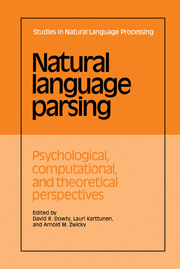Book contents
- Frontmatter
- Contents
- Contributors
- Acknowledgments
- Introduction
- 1 Measuring syntactic complexity relative to discourse context
- 2 Interpreting questions
- 3 How can grammars help parsers?
- 4 Syntactic complexity
- 5 Processing of sentences with intrasentential code switching
- 6 Tree adjoining grammars: How much context-sensitivity is required to provide reasonable structural descriptions?
- 7 Parsing in functional unification grammar
- 8 Parsing in a free word order language
- 9 A new characterization of attachment preferences
- 10 On not being led up the garden path: the use of context by the psychological syntax processor
- 11 Do listeners compute linguistic representations?
- Index
5 - Processing of sentences with intrasentential code switching
Published online by Cambridge University Press: 25 January 2010
- Frontmatter
- Contents
- Contributors
- Acknowledgments
- Introduction
- 1 Measuring syntactic complexity relative to discourse context
- 2 Interpreting questions
- 3 How can grammars help parsers?
- 4 Syntactic complexity
- 5 Processing of sentences with intrasentential code switching
- 6 Tree adjoining grammars: How much context-sensitivity is required to provide reasonable structural descriptions?
- 7 Parsing in functional unification grammar
- 8 Parsing in a free word order language
- 9 A new characterization of attachment preferences
- 10 On not being led up the garden path: the use of context by the psychological syntax processor
- 11 Do listeners compute linguistic representations?
- Index
Summary
Speakers of certain bilingual communities systematically produce utterances in which they switch from one language to another possibly several times, in the course of an utterance, a phenomenon called code switching. Production and comprehension of utterances with intrasentential code switching is part of the linguistic competence of the speakers and hearers of these communities. Much of the work on code switching has been sociolinguistic or at the discourse level, but there have been few studies of code switching within the scope of a single sentence. And until recently, this phenomenon has not been studied in a formal or computational framework.
The discourse level of code switching is important; however, it is only at the intrasentential level that we are able to observe with some certainty the interaction between two grammatical systems. These interactions, to the extent they can be systematically characterized, provide a nice framework for investigating some processing issues both from the generation and the parsing points of view.
There are some important characteristics of intrasentential code switching which give hope for the kind of work described here. These are as follows. (1) The situation we are concerned with involves participants who are about equally fluent in both languages. (2) Participants have fairly consistent judgments about the “acceptability” of mixed sentences. (In fact it is amazing that participants have such acceptability judgments at all.) (3) Mixed utterances are spoken without hesitation, pauses, repetitions, corrections, etc., suggesting that intrasentential code switching is not some random interference of one system with the other.
- Type
- Chapter
- Information
- Natural Language ParsingPsychological, Computational, and Theoretical Perspectives, pp. 190 - 205Publisher: Cambridge University PressPrint publication year: 1985
- 84
- Cited by

